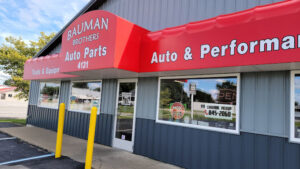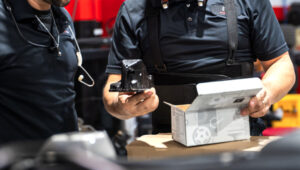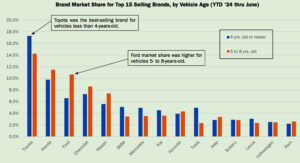Recent nationwide survey explores consumer perceptions of Dealers and Service Stations & Garages in four repair factors
Fort Wayne, Ind.—The driving public has developed different perceptions of Service Stations & Garages and Dealers across four key repair factors: Convenience, Technical Repair Capacity, Low Price, and Fair Price. These perceptions have changed over the past five years as Dealers reposition themselves in the do-it-for-me marketplace (DIFM) and Service Stations & Garages have been affected by competitive forces and the effects of COVID-19.
According to the latest Lang Aftermarket iReport, the way consumers perceive Service Stations & Garages compared to Dealers have influenced different directions the two groups have taken in the car and light truck DIFM.
Two Major Outlet Performance Factors
In a recent nationwide survey, Lang Marketing explored consumer perceptions of Dealers and Service Stations & Garages for each of four repair factors:
• Convenience of Repair
• Technical Repair Capacity
• Low Price
• Fair Price
The Lang iReport focuses on how consumer perceptions of Service Stations & Garages and Dealers have changed over the past five years (2018 to 2023). The following are key takeaways from Lang’s analysis.
Convenience of Repair
Service Stations & Garages receive their highest consumer ratings for Convenience of repair, much higher than Dealers. The Convenience of Service Stations & Garages is mainly based on their ubiquitous locations. Over the past five years, they have averaged about 110,000 outlets nationwide, topping 50% of all light vehicle repair shops.
However, COVID-19 affected Service Stations & Garages, and their population fell by double digits between 2018 and 2023. For many consumers, the Convenience of using Service Stations & Garages has diminished along with their population decline.
Technical Repair Capacity
Consumers rate Dealers significantly higher than Service Stations & Garages for Technical Repair Capacity. Consumers differ in how they perceive the tech-repair gap between these two outlet groups, depending on their vehicle’s nameplate (domestic versus foreign) and its age.
Consumers give much higher ratings to Dealers’ Technical Repair Capacity in terms of foreign nameplates than to Service Stations & Garages. Consumers also perceive Dealers as having greater Technical Repair Capacity in servicing domestic nameplates than Service Stations & Garages, but the difference is less than with foreign nameplates.
Dealers are perceived to have significantly higher Technical Capacity for newer vehicles than Service Stations & Garages. This difference is somewhat lower among consumers with older vehicles. Service Stations & Garages have not succeeded in improving consumers’ perception of their Technical Repair Capacity.
Low Price
Consumers continue to believe that Service Stations & Garages offer Lower Prices than Dealers across many repair jobs. In fact, consumer perceptions of differences between these two outlet groups, across the four factors measured, are most significant for Low Price.
However, Dealers, aware of their previous shortcomings, have made concerted efforts to become more price competitive, especially for routine repair jobs (oil changes, brake work, etc.).
In addition, many Dealers are offering aftermarket brands in the repair of older vehicles, as they open their bays to a wider array of vehicle nameplates and age groups. This is proving effective, and today the perceived price gap between Service Stations & Garages and Dealers has narrowed in the minds of many consumers.
Fairness of Price
Consumers also perceive that Service Stations & Garages offer fairer prices than Dealers. This difference is less pronounced among consumers owning foreign nameplates and more recent model cars and light trucks.
While Service Stations & Garages still hold an edge over Dealers in consumers’ perceptions of fairness of price, Dealers are making progress in this area by offering greater Convenience than Service Stations & Garages and using Convenience and Technology Expertise to make their prices seem fairer to consumers.
Convenience of Repair Changing Perceptions
Although Service Stations & Garages continue to receive higher consumer ratings for Convenience of repair, Dealers have made inroads. By offering Quick Lube services, Quick-Service Lanes, and extended business hours, Dealers have focused on Convenience as a significant means of capturing a growing share of the DIFM market.
Market Results
Over the past five years, Dealers’ efforts to change consumer perceptions appear to have worked.
Today, consumers perceive Dealer repair as more Convenient, Lower Priced and Fairer Priced than five years ago. At the same time, the consumers’ perceived tech gap between Dealers and Service Stations & Garages in Technical Repair has widened.
While some of these changes have been caused by external forces such as COVID-19, Dealers’ actions have played a significant part. Market changes are affecting consumers’ perceptions, but changing consumers’ perception are also impacting the repair market shares of Dealers and Service Stations & Garages.
Dealers significantly increased their DIFM share between 2018 and 2023, as Service Stations & Garages have declined in DIFM strength. With many Dealers focused on expanding their service bay business as a major pillar of their profit programs, Lang Marketing expects this trend will continue. The result will be a growing share of total DIFM volume captured by Dealers and a decline in the share of Independent (non-Dealer) outlets.









Comments are closed.